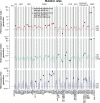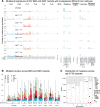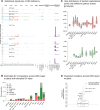Protection of the C. elegans germ cell genome depends on diverse DNA repair pathways during normal proliferation
- PMID: 33905417
- PMCID: PMC8078821
- DOI: 10.1371/journal.pone.0250291
Protection of the C. elegans germ cell genome depends on diverse DNA repair pathways during normal proliferation
Abstract
Maintaining genome integrity is particularly important in germ cells to ensure faithful transmission of genetic information across generations. Here we systematically describe germ cell mutagenesis in wild-type and 61 DNA repair mutants cultivated over multiple generations. ~44% of the DNA repair mutants analysed showed a >2-fold increased mutagenesis with a broad spectrum of mutational outcomes. Nucleotide excision repair deficiency led to higher base substitution rates, whereas polh-1(Polη) and rev-3(Polζ) translesion synthesis polymerase mutants resulted in 50-400 bp deletions. Signatures associated with defective homologous recombination fall into two classes: 1) brc-1/BRCA1 and rad-51/RAD51 paralog mutants showed increased mutations across all mutation classes, 2) mus-81/MUS81 and slx-1/SLX1 nuclease, and him-6/BLM, helq-1/HELQ or rtel-1/RTEL1 helicase mutants primarily accumulated structural variants. Repetitive and G-quadruplex sequence-containing loci were more frequently mutated in specific DNA repair backgrounds. Tandem duplications embedded in inverted repeats were observed in helq-1 helicase mutants, and a unique pattern of 'translocations' involving homeologous sequences occurred in rip-1 recombination mutants. atm-1/ATM checkpoint mutants harboured structural variants specifically enriched in subtelomeric regions. Interestingly, locally clustered mutagenesis was only observed for combined brc-1 and cep-1/p53 deficiency. Our study provides a global view of how different DNA repair pathways contribute to prevent germ cell mutagenesis.
Conflict of interest statement
The authors have declared that no competing interests exist.
Figures






Similar articles
-
DNA repair, recombination, and damage signaling.Genetics. 2022 Feb 4;220(2):iyab178. doi: 10.1093/genetics/iyab178. Genetics. 2022. PMID: 35137093 Free PMC article. Review.
-
Homologous recombination is required for genome stability in the absence of DOG-1 in Caenorhabditis elegans.Genetics. 2006 Jun;173(2):697-708. doi: 10.1534/genetics.106.056879. Epub 2006 Mar 17. Genetics. 2006. PMID: 16547095 Free PMC article.
-
Loss of Caenorhabditis elegans BRCA1 promotes genome stability during replication in smc-5 mutants.Genetics. 2014 Apr;196(4):985-99. doi: 10.1534/genetics.113.158295. Epub 2014 Jan 14. Genetics. 2014. PMID: 24424777 Free PMC article.
-
Caenorhabditis elegans HIM-18/SLX-4 interacts with SLX-1 and XPF-1 and maintains genomic integrity in the germline by processing recombination intermediates.PLoS Genet. 2009 Nov;5(11):e1000735. doi: 10.1371/journal.pgen.1000735. Epub 2009 Nov 20. PLoS Genet. 2009. PMID: 19936019 Free PMC article.
-
DNA repair.WormBook. 2006 Jan 13:1-12. doi: 10.1895/wormbook.1.54.1. WormBook. 2006. PMID: 18050489 Free PMC article. Review.
Cited by
-
BRCA1/BRC-1 and SMC-5/6 regulate DNA repair pathway engagement during Caenorhabditis elegans meiosis.Elife. 2024 Aug 8;13:e80687. doi: 10.7554/eLife.80687. Elife. 2024. PMID: 39115289 Free PMC article.
-
Experimental systems for the analysis of mutational signatures: no 'one-size-fits-all' solution.Biochem Soc Trans. 2023 Jun 28;51(3):1307-1317. doi: 10.1042/BST20221482. Biochem Soc Trans. 2023. PMID: 37283472 Free PMC article.
-
Dynamic alternative DNA structures in biology and disease.Nat Rev Genet. 2023 Apr;24(4):211-234. doi: 10.1038/s41576-022-00539-9. Epub 2022 Oct 31. Nat Rev Genet. 2023. PMID: 36316397 Free PMC article. Review.
-
DNA repair, recombination, and damage signaling.Genetics. 2022 Feb 4;220(2):iyab178. doi: 10.1093/genetics/iyab178. Genetics. 2022. PMID: 35137093 Free PMC article. Review.
-
Helicase Q promotes homology-driven DNA double-strand break repair and prevents tandem duplications.Nat Commun. 2021 Dec 8;12(1):7126. doi: 10.1038/s41467-021-27408-z. Nat Commun. 2021. PMID: 34880204 Free PMC article.
References
Publication types
MeSH terms
Substances
Grants and funding
LinkOut - more resources
Full Text Sources
Research Materials
Miscellaneous

